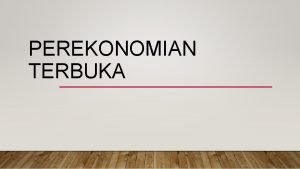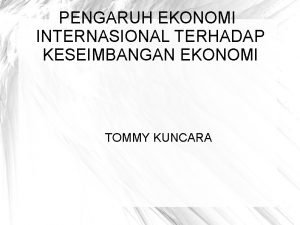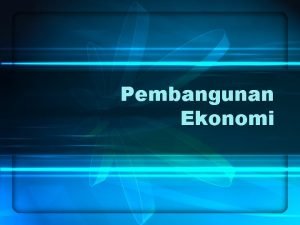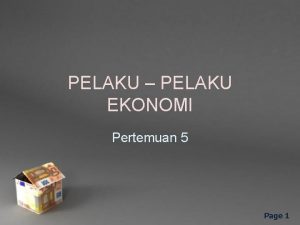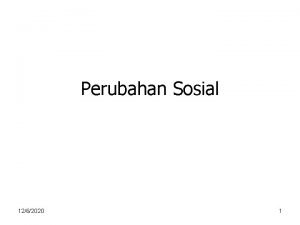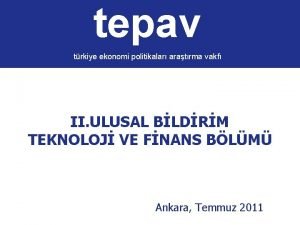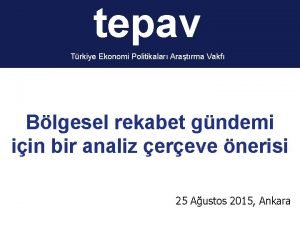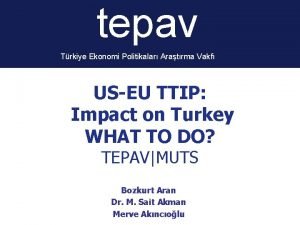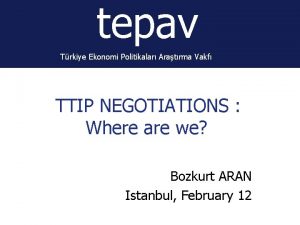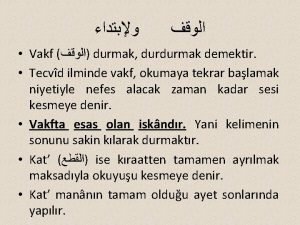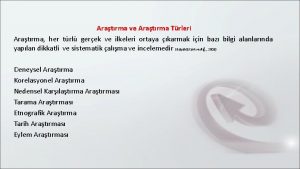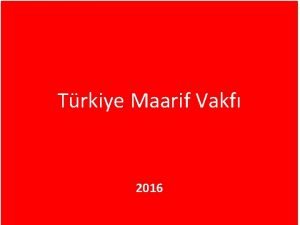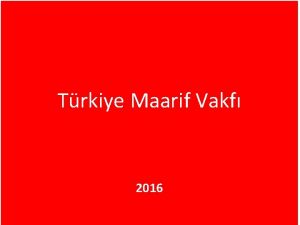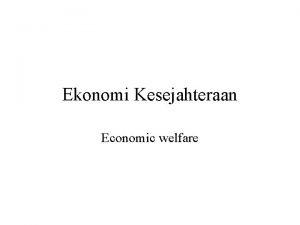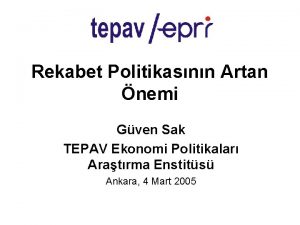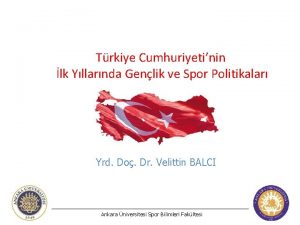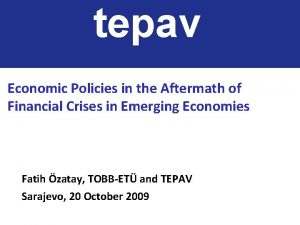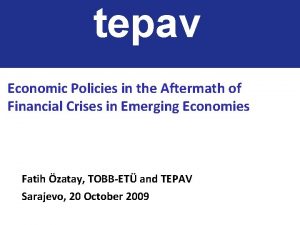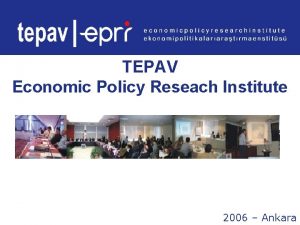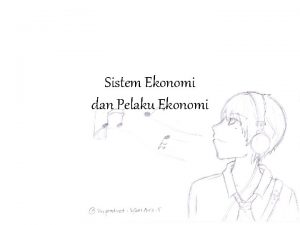tepav Trkiye Ekonomi Politikalar Aratrma Vakf The Economic









































- Slides: 41

tepav Türkiye Ekonomi Politikaları Araştırma Vakfı The Economic Crisis Impact on Industrial Relations National System in Turkey Policy Responses As Key Recovery Tools Sibel Güven Sofia, 16 th November 2012

Outline n Methodology n Framework of Industial Relations in Turkey n Current legislation and social dialogue mechanisms n Impact of the 2008 crisis on the Turkish economy and employment n Government policy responses to the crisis and its costs n Policy responses and social dialogue at three different levels è National level è Cross-sectoral level è Company level n Conclusion

Methodology n Desk research èData from Turk. Stat, the Ministry of Work, Employment and Social Security, OECD n Face-to-face interviews with the stakeholders: è 8 interviews with trade unions, employers’ associations, private companies and the government officials n National debate (Oct 16, 2012): èConsisted of all stakeholders

6 5 4 3 2 1 0 Trade union members Trade unions 25 20 15 10 5 0 19 8 19 6 8 19 8 9 19 0 9 19 2 9 19 4 9 19 6 9 20 8 0 20 0 0 20 2 0 20 4 0 20 6 08 Trade union density 1961 1966 1970 1977 1979 1980 1000 900 800 700 600 500 400 300 200 100 0 n 1950 s: The first well. Trade unions Trade union members (million) Development of an IR System in Turkey established unions n 1961 Constitution: A relatively more liberal environment n 1980 military intervention: suppression of trade unions è constitution and trade union laws were changed è Trade union development suspended è Some trade unions were closed è Unions lost influence and informal employment increased Source: OECD

Key statistics Number of Collective Agreements 6 5000 5 4000 4 3000 3 Number of Members Number of Non-Member Eligible Workers 2009 2008 2007 Public Trade Unions 2006 Private Trade Unions 2005 0 2004 0 2003 1000 2002 1 2000 2 2000 Millions Number of Trade Union Members (2009) Number of Collective Agreements Source: Ministry of Work, Employment and Social Security

Current legislative framework n Labour Code No. 4857, enacted in 2003 n Trade Union Law for Public Servants, enacted in 2001 - grants union membership rights to public servants n New law “Law on Public Servants and Collective Agreement” on April 11, 2012 – gives collective bargaining rights but not the right to strike to public workers n Trade Unions Act (no. 2821), enacted in 1983 and Collective Labour Agreement, Strike and Lockout Act (no. 2822), adopted in 1983 just became ineffective (November 2012) n A comprehensive new law instead of no. 2821 and 2822 was legislated: “Law on Trade Unions and Collective Bargaining”

Changes introduced so far by the new law on trade unions and collective bargaining n Amendments that are accepted so far: è Notary signature is no longer obligatory for becoming or leaving the membership è è è of a trade union Membership to a trade union will continue for another year if the worker becomes unemployed Trade unions and confederations are permitted to open international representative offices If a case is submitted to courts on grounds that the employment contract is terminated due to union membership reasons, the burden of proof will be on the employer Lines of business (sectors) where workers can be represented by trade unions have been aggregated into 20 from 28 Minimum age to become a member of a trade union has been reduced from 16 to 15 Financial auditing of trade unions and confederations will be conducted by certified public accountants (CPA) n Aggreement on the remaining clauses reached and new law enacted at the beginning of November

Social Dialogue Partners Public Sector • • • TİSK TOBB TÜSİAD MÜSİAD TİM TESK Employers’ organizations SOCIAL DIALOGUE • • • TÜRK-İŞ DİSK HAK-İŞ MEMUR-SEN TÜRKİYE KAMU-SEN KESK Trade unions

Major employers’ organization Turkish Confederation of Employers’ Associations (TİSK) è 22 Employers’ associations Professional associations* Turkish Confederation of Tradesmen and Craftsmen (TESK) Union of Turkish Chambers of Agriculture (TZOB) è 13 occupational federations è 82 unions of tradesmen and craftsmen chambers è 727 chambers of agriculture Union of Chambers of Turkish è 23 occupational Engineers and chambers Architects (TMMOB) * Professional associations which are active stakeholders of the industrial relations system in Turkey

Other associations that represent the private sector The Union of Chambers and Commodity Exchanges of Turkey (TOBB) Turkish Industry and Businessmen’s Association (TÜSİAD) Turkish Exporters Assembly (TİM) Independent Industry & Businessmen’s Association (MÜSİAD)

Major trade union confederations Confederation of Turkish Trade Unions (TÜRK-İŞ) Progressive Workers’ Union Confederation (DİSK) Confederation of Turkish Real Trade Unions (HAK-İŞ) è 35 trade unions è 17 trade unions è 13 trade unions Confederation of Public Employees Trade Unions è MEMUR-SEN: 11 trade unions è KESK: 11 trade unions è KAMU-SEN: 12 trade unions

Social Dialogue Platforms in Turkey n The Economic and Social Committee n The Tripartite Advisory Board n The Minimum Wage Setting Commission n The Coordination Council for the Improvement of Investment Climate - Employment Technical Committee

The Economic and Social Committee n Founded in March 1995, became a constitutional body in 2010 n According to the Economic and Social Council Law (2001), the Council consists of: è Prime Minister, Ministers of Development, Finance, Economy, Labor and Social Security, Agriculture and Husbandry, Industry and Commerce, Energyand Natural Resources, and the Undersecretaries of these Ministries è TOBB, TÜRK-İŞ, TİSK, TESK, TZOB, HAK-İŞ, DİSK è Other social partners nominated by the Prime Minister n Duties and responsibilities: è To include all the social and economic partners in the process of economic and social policy making è To monitor and adapt the studies made and the decisions taken by the Economic and Social Council of the European Union

The Tripartite Advisory Board n Established under the law no. 4857 in 2003 n Its members are Minister or the Undersecretary of Employment and Social Security, a representative from è The first 3 workers’ unions that have the highest number of members, è 3 representatives from the employers’ union with the highest number of members, è A representative from each public workers’ union. n The Board meets 3 times in a year (in January, May and September) and according to the workers’ and employers’ organizations, it is the most effective of all social dialogue mechanisms in Turkey.

The Minimum Wage Setting Commission n According to Labour Code (no. 4857) Act 39, minimum wages are to be set by the Ministry of Labour and Social Security through the Minimum Wage Setting Commission n The commission consists of the representatives of: è Ministry of Labour and Social Security è Ministry of Development è Turkish Statistical Institute è Treasury è The Labor Union Confederation that has the highest number of members (TÜRK-İŞ) è The Employer Union Confederation with the highest number of members (Ti. SK)

Technical Committee for Employment (The Coordination Council for the Improvement of Investment Climate) n Its aim is to include every partner in the formulation of employment-related policies n Participants: èUnder the presidency of the Ministry of Employment and Social Security, èWorkers confederations (TÜRK-İŞ, HAK-İŞ, DİSK) èEmployers’ confederation (TİSK) èOther related associations such as TOBB, TÜSİAD, TESK, YASED, TZOB, TİM

Does social dialogue work in Turkey? n The post-1980 de-unionization process have seriously weakened trade unions in Turkey: è Public servants have collective bargaining rights but not the right to strike and lock-out – scale tips against them è Majority of trade unions say they cannot take part in the policy- making process (exception: HAK-İŞ) è Partners claim that The Economic and Social Committee is not working effectively è Trade unions views and arguments are not given due consideration in The Coordination Council for the Improvement of Investment Climate - Technical Committee for Employment n Social Dialogue Partners who participated in National Debate held on 16 October 2012 confirmed these views,

Findings of the study were presented at the National Debate

The current bottleneck in social dialogue n In order to for a trade union to make a collective agreement, at least 10% of the total workers in that line of business should be union members. è The Ministry of Employment and Social Security has not renewed union data since 2009 – so there is a mismatch of data between the Ministry and the Social Security Institution è No collective agreements can be signed since February 2012 n The new law that has been enacted after the report was written changes the current industrial relations system in favor of workers and unions.

Crisis and challenges of social dialogue

Impact of Global Economic Crisis on Turkey 10 Economies that Contracted the Most in 2009 Finland -8. 3 Russia -7. 9 Hungary -6. 7 Mexico -6. 5 Japan -6. 3 Denmark -5. 2 Sweden -5. 1 Italy -5. 1 United Kingdom -5 Turkey -4. 7 10 Economies that Grew Most Rapidly in 2010 Singapore 14. 5 Taiwan 10. 8 China 10. 3 Argentina 9. 1 Turkey 8. 9 India 8. 6 Thailand 7. 8 Brazil 7. 5 Malaysia 7. 2 Hong Kong 6. 9 Source: The Economist, TEPAV n Turkey suffered severely from the crisis, but it recovered quickly è Comprehensive banking reforms after the 2001 economic crisis è Accumulated Knowledge and Experience from past economic crises Turkey lived

GDP Growth rate Share of demand in GDP Turkey recovered from the crisis by the increase in domestic demand External demand (share in GDP) Domestic demand (share in GDP) GDP growth Source: Turkey Data Monitor

120 2005 Q 1 2005 Q 2 2005 Q 3 2005 Q 4 2006 Q 1 2006 Q 2 2006 Q 3 2006 Q 4 2007 Q 1 2007 Q 2 2007 Q 3 2007 Q 4 2008 Q 1 2008 Q 2 2008 Q 3 2008 Q 4 2009 Q 1 2009 Q 2 2009 Q 3 2009 Q 4 2010 Q 1 2010 Q 2 2010 Q 3 2010 Q 4 2011 Q 1 2011 Q 2 2011 Q 3 2011 Q 4 Quarterly indez, 2005 Q 1= 100 (adjusted for seasonality) Employment in manufacturing was the worst affected Changes in employment in each sector 130 Agriculture 125 Manufacturing Services 115 110 105 100 95 90 85 80 Source: TÜİK

Trends in unemployment during the crisis Educational level 15 -24 Primary school and 16% less Middle school 11% Higher education 7% 25 -34 35+ Total 17% 24% 57% 9% 6% 25% 9% 3% 18% Female Male 2, 0 1, 5 1, 0 highest unemployment share was Primary school graduates or the less educated. n While male 0, 5 07 07 08 08 09 09 10 10 11 11 12 0, 0 Jan Apr Jul Oct Jan Apr Jul Oct Jan Million people (adjusted for seasonality) the ages 35 -54 the rate of increase of unemployment was the highest n Those who had the Unemployed according to gender 2, 5 n For those between unemployment rose, female labor force participation rate increased. Source: TÜİK

Government Responses to the crisis… n Employment package: è 5% reduction in the social security premiums è 11% increase in unemployment benefits, è Increase in incentives paid for the injured and the disabled from the Treasury (50 %) n Debt restructuring for bad cheques, credit cards and other credits n Increased short-time work allowances to prevent job layouts

…were possible with the help of the social dialogue partners! n Temporary tax reductions n Investment incentive programs: corporate tax reductions n Loosening of the restrictions on the employment of contract labour n Increase in government investment programmes n Active labour market policies

Cost of Government Responses Estimated Fiscal Expenditures (Million TL) Reduction of employers' social security contributions Expansion of activities on vocational training Reduction of social security contributions for young and female workers Recalculation of unemployment insurance payment in terms of gross instead of net amount Increase of short-term working allowances by 50 percent Social work programs Total cost of the measures to stimulate employment Share in GDP (%) 2008 2009 2010 (estimated) 2008 -2010 17 3, 726 4, 327 8, 070 152 343 495 16 66 137 219 40 119 87 246 162 106 268 78 151 229 73 4, 303 5, 000 9, 527 0. 01 0. 45 0. 49 Kaynak: Ercan, Taymaz ve Yeldan (2010) “Kriz ve Türkiye: Kriz Tedbirlerinin Etki Değerlendirmesi”, ILO

Health and education sectors severely affected from the crisis n Severe demand reductions for the private sector companies in both sectors n Reversal of the trend to increase the share of health in total social spending: shares of health and education converged after the 2008 crisis. Share of education and share of health in total social spending 0, 3 0, 28 Share of education 0, 26 0, 24 Share of health 2010 2009 2008 2007 2006 2005 2004 2003 0, 2 2002 0, 22 2001 % Source: Turk. Stat

Three levels of social dialogue in Turkey National level Cross-sectoral level Company level • Government policies • Union activities • Activities of professional and employers’ unions • Campaigns • Policies specific to sectors • Intra-company aggrements between different companies • Restucturing attempts • Agreements with employees: o Cancellation of salary increases o policies and practises to cut expenses

Example of Social dialogue: National level 5 -week campaign initiated by TOBB with the participation of many unions and organizations such as TÜRK-İŞ, HAK-İŞ, TESK, TİSK, KAMU-SEN, TİM, TÜSİAD ve MÜSİAD n “There Is a Remedy for the Crisis” – n Each campaign targeted different social groups such as women, workers or employers n Municipalities helped distribute the posters in all cities n Main goal: increasing domestic consumption by stimulating households to spend

Result : Increase in Consumer Confidence None 90 Consumer Confidence Index n A significant 80 70 60 Sep. 08 Oct. 08 Nov. 08 Dec. 08 Jan. 09 Feb. 09 Mar. 09 Apr. 09 May. 09 increase in domestic demand consumer confidence following the start of the campaign in March 2009. Source: Central Bank of Turkey n The campaign is an example of solidarity that brought together different social partners. n An alternative to the bottleneck experienced in the traditional social dialogue mechanisms with voluntary cooperation of all stakeholders.

Examples of Social Dialogue: Cross-sectoral Level (1) n SKILLS’ 10 Project: Reducing structural unemployment è Initiated by Turkish Ministry of Employment and Social Security, the Turkish Ministry of National Education, the Union of Chambers and Commodity Exchanges of Turkey (TOBB) and the TOBB University of Economics and Technology. n Unemployed were given six months training: è Theoretical training in the vocational high schools è On-the-job training. n The project helped solve the temporary unemployment problem in the crisis and is a step to solve the structural unemployment problem

Social Dialogue: Cross-sectoral Level (2) n Steelworkers’ union: Collective bargaining in the steel industry in 2009 resulted in a voluntary 35% reduction in wages for 16 months – after that workers’ wage losses were compensated without any reflection on their welfare benefits. n This practice is said to have prevented particularly the bankruptcy of the steel company ISDEMİR, and the shutdown of the company’s factories in Iskenderun. n The reduction in wages provided a very favourable alternative to the 2, 000 workers in the industry, for if it was not for the wage reductions these workers would have lost their jobs.

Examples of Social Dialogue: Company Level n Ford Otosan had to locate 410 voluntary employees to Arçelik-LG air conditioner factory (both are joint ventures of Koç Holding with Ford and LG Electronics) in order not to close down the factory è The employees volunteered to work in another factory è Their employment and social security status were not affected from the change. n MESA Hospital: managed to survive the crisis without obtaining loans in order to pay wages, and closed 2009 with a higher profit rate than 2008. No employee was laid off. è Simple cost-saving measures (lightbulbs, elevators etc. ) è Close dialogue with workers: established a council from staff to discuss cost reducing measures

Policy responses to social dialogue

TEPAV, 16 th October 2012 Many trade union confederations attended the national debate in Turkey

Impact of Social Dialogue (1) n TOBB’s project “There is a Remedy for the Crisis” has been the most prominent example of social dialogue that è Brings all private sector stakeholders together • Employers’ unions, trade unions and occupational unions è Demonstrates solidarity around the common purpose of recovery from the crisis as a whole n Impact of the campaign: significant increase in domestic demand consumer confidence

Impact of Social Dialogue (2) n Vocational training through public-private partnership: SKILLS’ 10 è Started as a measure to reduce temporary unemployment è Stakeholders realized it could help solve the structural unemployment problem è Until now; • 38 thousand trainees have been trained • 20 thousand trainees were employed

Impact of Social Dialogue (3) n The Confederation of Tradesmen and Craftsmen’s (TESK) accomplishments for policy: Preparing the draft for regulations è Restructuring of credit card debt è Restructuring of social security contribution payments è Restructuring of assets transeffered to asset management companies

Impact of Social Dialogue (4) n TÜRK-İŞ contributed several other measures that would protect workers from being laid off due to the global economic crisis: è Provision of a condition on the social security contributions, stating that no worker should be laid off on account of the crisis è Restructuring of debts, drafted by TESK, should include consumer credits and credit card debts è Utilization and increase of unemployment benefits, using the Unemployment Insurance Fund è Protection and improvement of the right to acquire severance payments è Increasing the purchasing power, and therefore domestic demand of public sector employees by granting them the right for collective bargaining.

Conclusion n The traditional social dialogue mechanisms has not been working effectively in Turkey. n The Turkish government was relatively late in responding to the global crisis. è This situation helped social dialogue partners to come together and act collectively è The private sector cooperated in responding to the crisis è Past crisis experiences in Turkey was a significant factor that caused Turkey not to be affected severely from the crisis n If the changes in the new legislation open the channels for social dialogue in Turkey, it will be a very significant step è Such strong dialogue legislation, platforms, and mechanisms would help Turkey minimize the effects of a possible future crisis.
 Contextualized minimal pairs examples
Contextualized minimal pairs examples Trkiye pronunciation
Trkiye pronunciation Angka pengganda dalam sistem ekonomi ekonomi terbuka adalah
Angka pengganda dalam sistem ekonomi ekonomi terbuka adalah Perbedaan matematika ekonomi dan non matematika ekonomi
Perbedaan matematika ekonomi dan non matematika ekonomi Pengaruh aspek internasional terhadap pendapatan nasional
Pengaruh aspek internasional terhadap pendapatan nasional Perbedaan pertumbuhan ekonomi dan pembangunan ekonomi
Perbedaan pertumbuhan ekonomi dan pembangunan ekonomi Pernyataan ekonomi positif adalah
Pernyataan ekonomi positif adalah Power point kegiatan ekonomi dan pelaku ekonomi
Power point kegiatan ekonomi dan pelaku ekonomi Kemajuan sosial adalah
Kemajuan sosial adalah Economic growth vs economic development
Economic growth vs economic development Economic development vs economic growth
Economic development vs economic growth Lesson 2 our economic choices
Lesson 2 our economic choices Tư thế worms-breton
Tư thế worms-breton ưu thế lai là gì
ưu thế lai là gì Thẻ vin
Thẻ vin Cái miệng nó xinh thế
Cái miệng nó xinh thế Thơ thất ngôn tứ tuyệt đường luật
Thơ thất ngôn tứ tuyệt đường luật Các châu lục và đại dương trên thế giới
Các châu lục và đại dương trên thế giới Từ ngữ thể hiện lòng nhân hậu
Từ ngữ thể hiện lòng nhân hậu Tư thế ngồi viết
Tư thế ngồi viết Diễn thế sinh thái là
Diễn thế sinh thái là Slidetodoc
Slidetodoc Giọng cùng tên là
Giọng cùng tên là Làm thế nào để 102-1=99
Làm thế nào để 102-1=99 Hát lên người ơi
Hát lên người ơi Khi nào hổ con có thể sống độc lập
Khi nào hổ con có thể sống độc lập đại từ thay thế
đại từ thay thế Quá trình desamine hóa có thể tạo ra
Quá trình desamine hóa có thể tạo ra Vẽ hình chiếu vuông góc của vật thể sau
Vẽ hình chiếu vuông góc của vật thể sau Công của trọng lực
Công của trọng lực Tỉ lệ cơ thể trẻ em
Tỉ lệ cơ thể trẻ em Thế nào là mạng điện lắp đặt kiểu nổi
Thế nào là mạng điện lắp đặt kiểu nổi Lời thề hippocrates
Lời thề hippocrates Dot
Dot Bổ thể
Bổ thể Vẽ hình chiếu đứng bằng cạnh của vật thể
Vẽ hình chiếu đứng bằng cạnh của vật thể Phản ứng thế ankan
Phản ứng thế ankan Môn thể thao bắt đầu bằng từ đua
Môn thể thao bắt đầu bằng từ đua Sự nuôi và dạy con của hổ
Sự nuôi và dạy con của hổ điện thế nghỉ
điện thế nghỉ Nguyên nhân của sự mỏi cơ sinh 8
Nguyên nhân của sự mỏi cơ sinh 8 Trời xanh đây là của chúng ta thể thơ
Trời xanh đây là của chúng ta thể thơ


